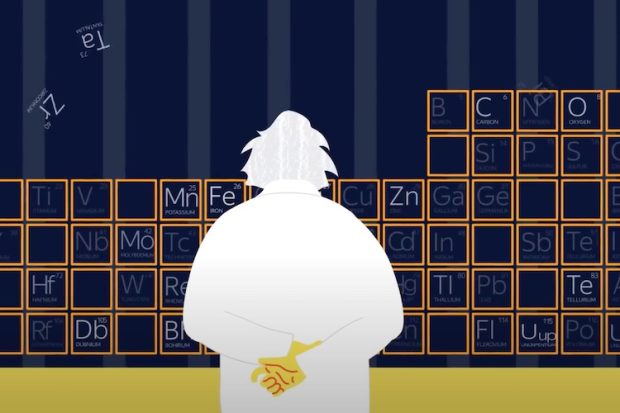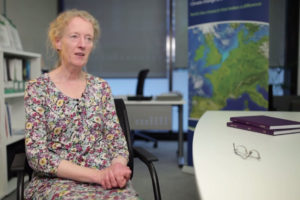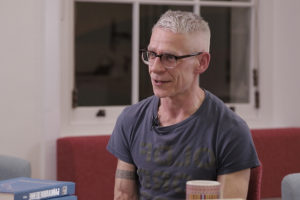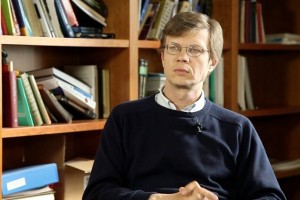Radiative Forcing of Climate Change
Physicist Joanna D. Haigh on greenhouse gases, the impact of aerosols on climate change, and how clouds reflec...
What processes are taking place in a melting substance on molecular level? What energetic balances are involved in solidification? At which moment does rapid melting start? Professor of Chemistry and Mathematics, New York University, Mark Tuckerman, describes how the process of transforming into another state of matter is organized.
All of us who take undergraduate science courses: physics, chemistry, – we have to learn about something called the “phase diagram”. The phase diagram tells us about the basic states in which a given substance can exist. Now, the usual things that we’re told are: the substance can exist either as a solid, or a liquid, or a gas. Most common substances exist in these basic states of matter, and what we learn from the phase diagram is that there are certain values of pressure and temperature for which the system naturally exists as a solid, there are certain values of pressure and temperature for which it naturally exists as a liquid, and then there are values of pressure and temperature for which it naturally exists as a gas. Sometimes we are also told about something called “the critical point”, beyond which this system exists as something called “the supercritical fluid”.
Whatever we are told, the problem of how a system undergoes a transition from one phase to another (what’s called “the phase transformation”) is usually sort of left to something that is not covered in these courses. And in around 2013 or so we began to undertake a study, in particular, how a simple solid (solids that we chose were the simple metals: copper and aluminum) would undergo the transformation from the solid to the liquid phase, so what we call “the melting transformation”.

Now, much of what I would say about the transformation from solid to liquid can also be applied to the reverse transformation of solidification, going from a liquid to a solid. This is a very, very common transformation that we experience on a daily basis. We see ice melting in our glasses of water, and if it is a cold winter day, we see puddles of water turn into ice. So, solidification and melting are something that everyone is pretty much familiar with. But the microscopic mechanism, how this actually happens, is something of a mystery. And it’s something that could actually be addressed using computational methods, which is an area in which my research is actually very, very active.
Now, what’s usually taught in these courses, and sort of what it is in historical perspective, if, for example, I’m interested in melting transition, – is a very simple thermodynamic theory called classical nucleation theory. What classical nucleation theory says, when we apply it to the melting transition, is that if I take a solid and I bring it up to its melting point – in a phase diagram the melting point is that temperature at which one has a line, a boundary between the solid and the liquid phases at a particular pressure – so, that melting point is where we would expect the system to undergo this transition.
And what classical nucleation theory tells us is that at the melting point the way the system melts is it begins by forming a small – what’s called “the nucleus” – a small region of the solid, where we have disorder. Disorder at the level of what it would look like if that region were actually the liquid. S, one begins by forming a small liquid nucleus, and that liquid nucleus then slowly grows over time, and if that nucleus riches a certain what’s called “critical size”, then the system will undergo an actual transformation, and nucleus will grow rapidly at that point, and the system will go from solid to liquid. In other words, you’ll experience a melting transition.
So, classical nucleation theory then describes what’s called the free energy to form the nucleus. And all that is, is a measure of the work that I need to form this nucleus in the system. And it tells us that there is an energetic price to pay, a thermodynamic energetic price that we need to pay to form this nucleus, and that that price is at the expense of there being a boundary between the solid and the liquid, which is usually a mismatch. The solid and the liquid often don’t want to coexist in that way, and so we have to pay a thermodynamic price to form that region where the solid and the liquid nucleus meet.
Now, there is an energetic gain as well to form a liquid of a certain volume in the system, so there is an energy balance there. There is the energetic price to pay for forming the surface of the liquid nucleus, but there is an energetic gain that we have in the formation of the nucleus.
When the gain becomes more than the price, that’s when you reach the critical nucleus size and that’s when the system is able to melt.
So, it’s a very intuitive theory, and the only parameter that you need to know about is the size of the liquid nucleus, because that’s really what determines this energetic balance that we pay, right?
The classical nucleation theory is a bit too simple. It doesn’t really capture the true microscopic behavior of the system. So it’s nice to be able to teach this, but it belies a complexity of microscopic behavior. That’s something that we set out to discover in our computational study, in the paper that came out in 2014 in Science, entitled “The Microscopic Mechanism of the Melting of the Solid”.
Now, the computational technique that we needed to apply here is one that deals with a truly ubiquitous problem in studies not only of phase transformations, but any time you have a very, very serious conformational change in the system – which is that the energetic price is rather high. And as a result, if you just apply standard computation approaches such as Monte Carlo, or molecular dynamics, where you’re just sampling a distribution, or you’re solving the equations of motion of the system, the probability that you will undergo the transformation that you are trying to study is extremely rare, because of the energy that’s required to affect this transformation. In the computational language we call this “rare events phenomena”. And it requires specialized techniques in order to treat this kind of problem.
So, this is something we’ve been working on in our research, which is to develop methods that are able to handle rare event problems. Well, usually they imply or they require that you add in some new ingredient into your computational approach, that’s actually able to accelerate the crossing or the amassing of energy in order to approach this high barrier. And we’ve had a lot of success in developing approaches like this that are applicable to the systems of biological interest. And it turns out that many of those techniques could also be applied in the melting transformation as well as studies of solidification and crystallization.
So, applying this approach we discovered something very interesting about the melting transition. Now, what we found in our study is that this idea of nucleation theory, this idea that the system just grows a nucleus from the inside out – from small to very large – is not actually what happens. So when a system approaches its melting point, so when we have a solid and we heat it up to the melting point, what actually happens in the system – and this is not actually completely counter-intuitive – is that we start to form liquid-like defects throughout the system.
So it’s not just one little nucleus that forms, but we actually form very small regions of liquid-like behavior. Now, these defects come in the form of a missing site in the solid, that’s called “the vacancy”, or, because we are close to the melting point, we also see that we could form what are called “interstitial defects”, and that’s where an atom comes in and fills a location in between two sites of my solid.
Now, as this embryo, if you will, this liquid nucleus begins to grow as a result of this defect diffusion, then you start to create a liquid nucleus that approaches this critical size that you might predict from nucleation theory. And as that happens, then the system can eventually undergo this transformation from the solid to the liquid. But it’s governed by free energy, which is more complex than nucleation theory predicts it is.
There are several energetic barriers that have to be crossed in order for this process that I’ve described to happen. The first is that we have to form these series of small defects; it’s not a high price to pay for that. But you have to pay a price to bring them together into an embryo, and that actually has some sort of energetic penalty to pay for it. It is largely governed by entropy, which, of course, says that these defects can go all over the place and the chances that they meet are rather low. But they do, and as they meet, then we have crossed the first barrier. And as the cluster of defects starts to grow, then we actually have the formation of a stable small liquid nucleus. Then there is another barrier to access, in which there’s this growth of the critical size, this little embryo grows to the critical nucleus size. That’s the second barrier – and then the system can transit from the solid to the liquid.
Now, the other thing that we discovered in our study is that that’s not the only way that this can happen, and there are actually multiple pathways for a system to go from solid to liquid, and presumably in the reverse transition from liquid to solid. The other process that we see is that these small defects can form what are called line dislocations. A line dislocation, rather than being a cluster, is actually a dislocation that extends in a thin line throughout the system, and that creates a kind of boundary between order and disorder. And the boundary region is one place where melting can easily initiated.
So when I have a boundary, that’s actually a place, where it’s favorable to grow small clusters of disorder, liquid-like disorder. And so, as these dislocations we see an amassing of these small liquid nuclei, these small embryos, they grow together to form a large one, and then, again, as this reaches the critical size, then we’re able to make the transition from the solid to the liquid. That’s actually a multi-barrier process, because one first has to form the line dislocation, then clusters have to grow along this dislocation, and finally the last barrier is the growth to a critical nucleus size.
So, that was another pathway that we discovered. And then finally we were interested in what happens if we take the system and we superheat it, so we go just a little bit beyond the melting point to where we would expect a rapid transition from solid to liquid. And indeed, in that case we find that there is a completely different mechanism that’s not governed by the formation of defects, and clusters, and nuclei.
In a superheated solid, a system will undergo a large amplitude vibration that essentially encompasses the entire solid.
Historically this was thought to be another mechanism of melting at the melting point. This was a mechanism that was put forth by Lindemann, and it turns out that this actually only governs what happens in a superheated solid. So what we discovered is that above the melting point, this large amplitude vibration then creates an instability in the system, allowing the system to basically have large-scale disorder, and then there is a rapid transition from the solid to the liquid as a result of this vibrational instability. But if you try to predict a melting point from that, of course, then you would get a wrong answer, because this only occurs in superheated solids. You will actually overestimate the melting point in doing this.
So, we found, really, two regimes: one, where we have a barrier that depends on the formation of this local defect cluster, and then the regime where we don’t have local defect formation, but really a process that accompanies the entire system.
What we learned in our study was relevant to a simple atomic solid, but what we are going to be interested in the future is what are the mechanisms of phase transformation from solid to liquid, liquid to solid of more complex systems. Molecular solids, for example, water, being the most common of these, but there is a whole variety of molecular solids, where things like orientation actually play an important role, which, of course, you don’t have in an atomic solid. And different types of interactions, so they may be hydrogen bonding that plays an important role, or the types of weak interactions. Are the mechanisms actually the same for a molecular solid as they are for an atomic solid?
For this, of course, the same types of techniques should be able to be applied, although we may have to think a little bit more about how we measure order and disorder in these systems, because of the fact that part of what creates disorder in a molecular solid is orientation disorder that we don’t have in an atomic solid. So, that will be something that we will need to think more about as we go forward. But I think it will be very, very interesting to see if the basic principles that we’ve uncovered in our study, could actually be applied and whether they will carry over to the case of molecular solids.

Physicist Joanna D. Haigh on greenhouse gases, the impact of aerosols on climate change, and how clouds reflec...

Geographer Anson Mackay on the freshwater resources, planetary boundaries and lake Urmia

Physicist Mikhail Lukin on quantum computers, atomic clocks, and new tools for exploring biological systems